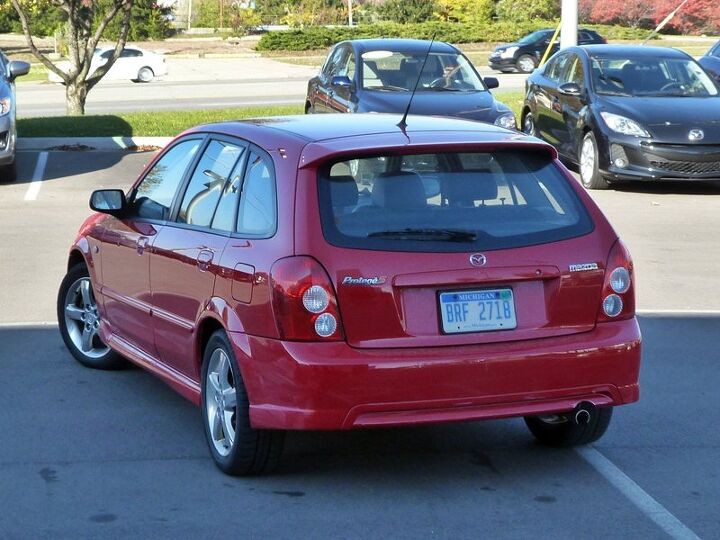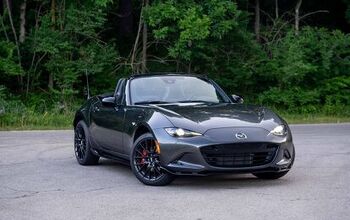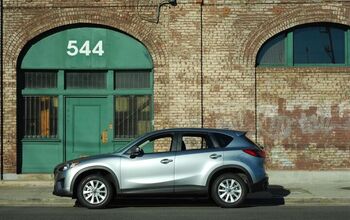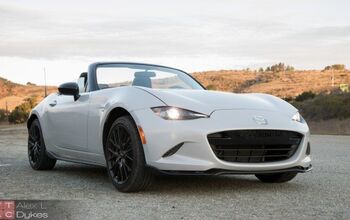Review: 2003 Mazda Protege5
I started contributing car reviews to TTAC back in 2006. Today’s is my last. But which car should I cover in my final TTAC review?
Why not write the review TTAC founder Robert Farago wouldn’t let me write? RF had a rule against reviewing our personal cars. But my 2003 Mazda Protege5 has been mentioned in quite a few of my reviews, and has been implicit in nearly all of them. RF’s rule went by the wayside some time ago, but the thought of reviewing the P5 didn’t cross my mind again. Until now.
When I bought my Protege5 back in November 2003, it was already at the end of its run. I got a great deal ($18,900 MSRP, paid $13,400) because the new Mazda3 was in transit. So the P5 was designed and engineered back in the mid-nineties. How does it possibly remain relevant today?
The Protege5 remains relevant for the same reasons I still own it. First of all, despite a 2,800-pound curb weight, the car’s reactions to steering inputs are quicker than in any compact hatch I’ve driven since buying it. Though the low-effort steering can have an over-assisted, rubber-band feel at modest lock under light loads (a trait shared by the current Civic Si), both on-center and when you’re tossing the car precisely through a curve the rack and column seem to transmit EVERTYTHING through a relatively thin, minimally padded rim to your fingertips. (The thick, heavily padded steering wheels favored by many people and consequently common on performance-oriented cars block feedback.) A MINI or a 500 should feel as agile and provide communication as plentiful and nuanced, but doesn’t.
By lifting off the Protege5’s throttle as you enter a turn you can coax the rear end out a bit, but in general the car’s chassis is extremely stable. Testing out the car’s handling early on in a snow-covered parking lot, I had to resort to pulling the hand brake to get it to spin. Even without stability control (which was never offered), every ounce of potential can be extracted from this car safely and easily. In subjective terms, the P5 feels so alive and is so much fun, even in daily driving, that it has made nearly every car I’ve reviewed over the past decade seem dull, even boring in comparison. Consider the Mazda Exhibit A in the case that it’s more fun to drive a slow car fast than a fast car slow.
Almost ridiculously large windows separated by thin pillars further contribute to driver confidence. If you can’t see something ahead, behind, or to the side of this car, you must be looking in a different direction. As in an NA or NB Miata, I wish I could lower the seat an inch or two. As is, you sit far above the compact instrument panel yet well below the windshield header. You can see the front end just enough to easily place it. (Unless you’re the au pair who once parked by feel, crinkling the front left fender.) To get this driving position in a current vehicle, you have to get a crossover. Even these often have tall, deep instrument panels lately.
The driver seat, though surprisingly supportive and comfortable for one in such an inexpensive car, doesn’t do as much for driver confidence. It might look like it would provide lateral support, but it doesn’t (especially not when upholstered in black leather). Front and rear seat height can be independently manually adjusted. Bean counters have since killed this feature in every compact (most recently in the Chevrolet Cruze).
The Protege5 is smaller than current compact hatches, but has a roomier back seat, perhaps because safety standards were quite a bit lower in the 1990s. My three kids have logged thousands of hours in the back seat of this car. A couple of adults will not only easily fit, but they’ll find better thigh support than in many much larger cars. The Protege5’s cargo area isn’t large—this is the rare wagon that has a significantly shorter rear overhang than the related sedan, such that it’s really a wagon in roofline only—but it has always been large enough for us.
Beyond the handling and driving position, back in 2003 I was smitten with the Protege5s styling, especially the rear quarter view. Mazda really finessed the area around the tail lamps when transforming the Protege sedan into a wagon. A tasteful body kit lends just the right amount of aggressiveness to the car—unlike some, it doesn’t overpromise or make someone in his forties feel ridiculous. Overseas, the car was offered without the body kit, and the car then looks a bit pudgy. Frankly, even with the kit the car appears a bit rotund from some angles. Car styling has gotten much edgier in the years since, and at this point the Protege5 looks its age, even if it will age better in the long-term than either generation of Mazda3. I prefer to think of the exterior as “classic.”
The highly polished, chrome-appearing rims now on the car don’t do it any favors, especially not when paired with red paint. They were on the car from the factory. I had the dealer swap wheels with another car, and credit me the $400 difference. But a few years later the finish peeled off the painted wheels. To replace them under warranty, Mazda shipped the wheels they thought were still on the car. The dealer then balked at replacing them at all, claiming that the flaking wheels were “aftermarket” because the selling dealer (no longer in business) hadn’t reported the swap to Mazda. I persuaded them that this was not my fault, and said I’d be more than happy to have them replace the painted wheels with painted wheels. But there was no way to have Mazda ship painted replacements, so it has worn shiny rims since.
The Mazda’s interior, well the interior is cheap, but honestly cheap. It doesn’t pretend to be something it’s not, and the door panels at least are soft to the touch. The controls are simple and within easy reach. Let’s consider the interior “classic” as well.
I suppose I must mention the P5’s engine, which has never ranked among the reasons I like the car. Under 2,000 rpm it gets the shakes and lugs. Over 4,000 rpm it runs out of breath (130 horsepower allegedly arrive at 6,000, but this isn’t obvious from behind the wheel). Between 2,000 and 4,000, though, it produces a good, solid pull with more character than you’ll find in a Mazda3 mill. Early on I replaced a tall shifter with one that halved the throws. Partly for this reason, the shifter isn’t always the smoothest, but at least you’re pulling and pushing on a rod and not a cable.
Fuel economy started out in the mid-20s, then increased to the high-20s as the engine broke in. Sometimes it tops 30. Thanks to short gearing (nearly 3,500 rpm at 70), highway fuel economy is a little lower than suburban fuel economy. For reasons of economy and noise, I’ve long wished for a sixth cog. (Some people do replace the fifth gear with one from the closely related transmission in the 626.)
Sometimes I fantasize about the powertrain I’d install in my Protege5 if cost weren’t much of an object. It couldn’t be one with much torque. Even the stock engine steers the car under hard acceleration. But a Civic Si powertrain might serve nicely. In reality, the most common significant powertrain mod is a turbo. But for me the Protege5 is about having fun in daily suburban driving, so I’ve never felt an urge for boost, especially as this would likely dull the engine’s responses pre-boost.
The Protege5’s reliability has been excellent, with one big exception. In 115,000 miles I’ve been through a couple sets of pads and rotors, a couple sets of front wheel bearings, front lower control arms, and stabilizer bar end links. Oh, and three sets of headlight bulbs, which are such a PITA to change I pay the dealer to do it.
The exception is rust. Where the roads are salted, small Mazdas predictably start to meld with atmosphere about six months after the five-year rust perforation warranty ends. Each fall I remove what rust I can from the rear wheel openings and shock towers, slap on some rust converter, then paint. I had more thorough rust repair performed once, a couple years ago. The rust has since returned. To thoroughly fix just the rear end a body shop will charge a couple grand, which can’t be rationally justified.
So, why does the auto industry no longer offer a car like this one in North America? Visibility was cast by the wayside due to styling trends. The chassis story is more complicated. The transition to electric power assisted steering (EPAS) for fuel economy reasons hasn’t helped, but even cars with hydraulic steering generally provide far less feedback (e.g. the Audis mentioned earlier, and BMW 5ers recently compared by C&D).
In a word, the reason is refinement. In sharp contrast to a current batting-way-above-its-league Focus, the Protege5 ain’t got none. After driving a Lotus Elise, the Protege5 felt as high, quiet, and cushy as a Lincoln Navigator. Compared to just about anything with four doors, though, the near-classic Mazda is rough and noisy. Wind noise, road noise, engine noise, transmission noise—the entire dyssymphony is present. NVH couldn’t have been much of a consideration when it was engineered. In years past I’ve had my entire five-person family in the car for a 700-mile trip. Looking back, I don’t know what I was thinking. This is not a highway car. For long trips we now have–what else?–a bigger wagon.
But isn’t there space for at least one affordable compact hatch that trades off refinement for responsiveness and feedback? Can’t at least one manufacturer take a chance on the possibility that the hand raisers would actually pull out their checkbooks? Until this happens—and it might never happen—I’ll stick with the Protege5 until rust takes out something essential (my pride if not a strut tower). For better and for worse, the Mazda delivers a visceral connection not only to the road, but to a bygone age.
Fortunately, there are still some car sites willing to trade refinement for responsiveness and feedback. My road at TTAC hasn’t always been straight or smooth, but smooth, straight roads are boring. With TTAC, whether headed by RF, Ed, or BS, there has never been a dull moment. Thanks, guys!
Michael Karesh operates TrueDelta.com, which covers car reliability, real-world fuel economy, feature-adjusted car price comparisons, and (as of this month) weekly “Why (Not) This Car?” reviews.
Michael Karesh lives in West Bloomfield, Michigan, with his wife and three children. In 2003 he received a Ph.D. from the University of Chicago. While in Chicago he worked at the National Opinion Research Center, a leader in the field of survey research. For his doctoral thesis, he spent a year-and-a-half inside an automaker studying how and how well it understood consumers when developing new products. While pursuing the degree he taught consumer behavior and product development at Oakland University. Since 1999, he has contributed auto reviews to Epinions, where he is currently one of two people in charge of the autos section. Since earning the degree he has continued to care for his children (school, gymnastics, tae-kwan-do...) and write reviews for Epinions and, more recently, The Truth About Cars while developing TrueDelta, a vehicle reliability and price comparison site.
More by Michael Karesh
Latest Car Reviews
Read moreLatest Product Reviews
Read moreRecent Comments
- Eric I would take the house, sell it at a profit to some poor schmuck and invest the profit in something other than "green technology".
- Urlik Of course the IIHS moves the goal posts. It’s all about staying relevant.
- The Oracle Good riddance.
- Lou_BC Makes sense. I've seen a few dealer inventories listing 2022 "heritage " Trucks .
- Lou_BC I doubt many will ever get any air time or shred a dune. Probably be fun on a logging road but anywhere else, it's as wide as a one ton dually.















































Comments
Join the conversation
I can't say Mazda's seem that exceptional. I like them better then the Japanese rental competition. But with automatics they weren't terrifically quick - that's for sure. No doubt the manual helps alot to make them more enjoyable. But still Volkswagen offer similiar dynamics (even better steering sometimes I think) and a similiar lack of power if that's your thing. I have to say I don't buy a slow car fast is more fun then a fast car slow (outside of extreme cases like a Ferrari.). What helps a car feel fun is a good weight balance and good drive train layout and low overall weight. Sure Miata's are fun but so are BMW 1 series. Power doesn't kill a cars fun..That's just silly.
Here’s my advice on some of the issues mentioned here and elsewhere about the P5. Headlight Bulbs: Two words: Dielectric grease. Put it all over the bulb prongs and in the sockets for both the bulb and its (black) adapter; it won’t short anything out. It will make the bulbs last longer and aid in their removal when they do die, and perhaps also keep the endpoint of the (white) wiring harness from turning black from heat. I went through a set of bulbs a year until I started applying the grease. NB: In 2002, the MP5's headlights were called out by Consumer Reports as being the best on any car that year in terms of distance and drop-off. Brakes: Get a manual and downshift properly. I replaced my factory brakes and trued the rotors at 86k miles. Funny thing is, just 10k miles later, the dealer is saying that my pads are halfway used up on the back wheels. They must have put some crappy pads on there. Tires: Kumho. Period. They’re cheap, they fit, and they stick. Lack of Power: Get a manual and/or exploit the power the car does have. Power has never been a problem for me in town or on the highway, and I have fun while driving. This is a balanced car and not meant to be a top fuel dragster. Noise: Ugh. The car is loud on the highway. If you have a sunroof and a roof rack, you can remove the crossbars on the roof rack and fill the gaps with the spacers provided with the car when new. Completely deleting the rails that run the length of the roof would be a PitA, as mentioned by 69firebird. Motor mounts: I hear they die, but mine never have. I do not brake suddenly, nor do jack-rabbit starts. I just drive the car spiritedly while it’s moving and take my foot off the gas well in advance when I know I’ll have to stop at a light, etc. Rust: Texas. Live in Texas. However, that has other challenges (see below). Vandalism: Don’t live in Texas if you have lefty bumper stickers. My car has been egged, smeared with lip gloss, and had all three wiper ARMS ripped off at a cost of $400 damage. A student caught jacking with my bumper stickers was sent to the campus’ judicial department. His defense: His family was friends with the Bush’s. Stupidity, mine and others: Never leave anything in sight inside any vehicle, even if it has no value. A homeless person busted into my car to steal a workout bag filled with sweaty clothing causing $500 damage. An oil change place left my filler cap off and I discovered it two months later. The entire engine was covered with a fine mist of oil and the insulation under the hood had to be replaced at their cost, but the dipstick indicated that the oil never dropped below full. Another oil change place broke my dipstick and cracked the air intake hose all within one visit, then tried to cover it up by taping the dipstick handle together. Air Conditioning: It does the job, but just barely. Get window tint from a reputable dealer. Do not get darker tint on back passenger windows, because that's just ghetto. :) Do get darker tint on the back hatch window, however, to cut down on headlight glare. Clouded headlights: If you can, garage it day and night and this won’t happen. Mine are crystal clear. Garaging a car will literally add years to its life. Mileage: Try hypermiling in city driving if you have a manual. What I, MK, redav, and replica understand - and what CelticPete clearly does not - is that Mazdas actually ARE viewed as exceptional by their owners. The satirical newspaper The Onion seems to understand this (Google “Man With Strong Brand Loyalty Willing To Kill For Mazda - The Onion”). When I bought my P5 in 2002, there were few hatchbacks available. I test drove a P5 without knowing they even existed. It made me smile and I bought it one week later after reading about how reliable they were. The first thing broke on my P5 two months ago after over ten years of ownership was a door lock actuator and I fixed it myself for less than $100. The car has aged very well in terms of looks and design, but it probably doesn't hurt that it’s black and garaged. Reading this article about the P5 is making me feel really uneasy about my plans to trade it in on BRZ/FRS... :( The car has always amazed me for what it offers, and every day it literally makes me feel smart for having bought it.